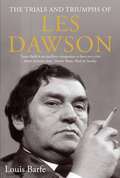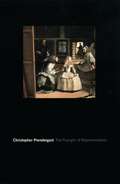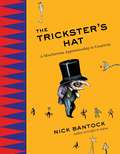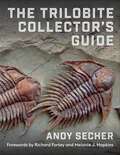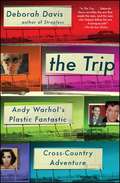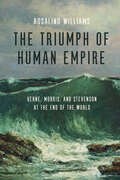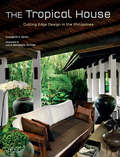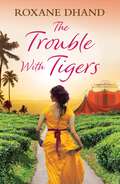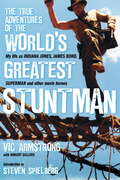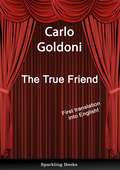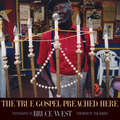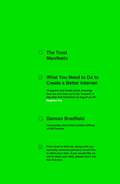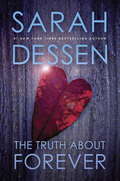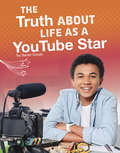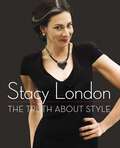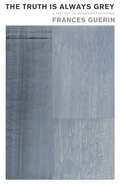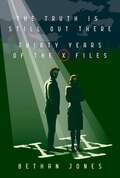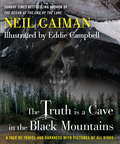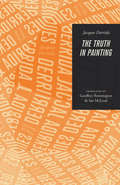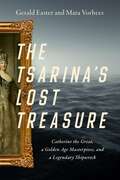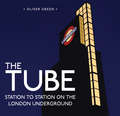- Table View
- List View
The Trialism and Application of Human Settlement, Inhabitation and Travel Environment Studies: Applications in Valley, Plain, Hilly, and Arid Regions
by Binyi LiuThis book studies human settlements in China in terms of Human Settlements Trialism in 4 typical human settlement types: valley, plain, hilly, and arid regions. Focusing on three elements of Trialism — (1) natural and constructed environments, resources, and visual landscapes in human settlements background; (2) survival strategies, customs, culture, and values in human settlements activity; and (3) the layout of time and space as well as the planning and design of the urban, the country, and the wilderness in human settlements construction — the book analyzes the evolution of human settlements and predicts future trends. Presenting academic researchers and graduate students in various fields with insights from landscape architecture, urban planning, architecture, geography, forestry, art, and psychology, the book discusses the principles of interactive physiological thinking and systematically theoretical philosophy related to professional physiology, planning and design principles, and traditional and modern methods and technologies in urban and rural construction. The innovative multi-discipline book promotes the planning and design of five types of human settlement, which is helpful to the judgment of value, activity rule, and living style of human settlements, and also discusses the development of human settlements in the new millennium.
The Trialism and Application of Human Settlement, Inhabitation and Travel Environment Studies: Applications in Water-net Region
by Binyi LiuThis book studies human settlements in China in terms of Human Settlements Trialism in 5 typical human settlement types: river valleys, water networks, hills, plains, and arid areas. Focusing on 3 elements of Trialism—(1) natural and constructed environments, resources, and visual landscapes in human settlements background; (2) survival strategies, customs, culture, and values in human settlements activity; and (3) the layout of time and space as well as the planning and design of the urban, the country, and the wilderness in human settlements construction—the book analyzes the evolution of human settlements and predicts future trends. Presenting academic researchers and graduate students in various fields with insights from landscape architecture, urban planning, architecture, geography, forestry, art, and psychology, the study discusses the principles of interactive physiological thinking and systematically theoretical philosophy related to professional physiology, planning and design principles, and traditional and modern methods and technologies in urban and rural construction. The innovative multi-discipline study promotes the planning and design of 5 types of human settlement, which is helpful to the judgment of value, activity rule, and living style of human settlements, and also discusses the development of human settlements in the new millennium.
The Trials and Triumphs of Les Dawson
by Louis BarfeThe first ever narrative biography of a towering figure in British comedy Les Dawson, more than any other comedian, spoke for the phlegmatic, pessimistic British way of life. A Northern lad who climbed out of the slums thanks to an uncommonly brilliant mind, he was always the underdog, but his bark was funnier and more incisive than many comics who claimed to bite. Married twice in real life, he had a third wife in his comic world—a fictional ogre built from spare parts left by fleeing Nazis at the end of World War II—and an equally frightening mother-in-law. He was down to earth, yet given to eloquent, absurd flights of fancy. He was endlessly generous with his time, but slow to buy a round of drinks. He was a mass of contradictions. In short, he was human, he was genuine, and that's why audiences loved him. This is his story.
The Triangle of Representation
by Christopher PrendergastMoving deftly among literary and visual arts, as well as the modern critical canon, Christopher Prendergast's book explores the meaning and value of representation as both a philosophical challenge (What does it mean to create an image that "stands for" something absent?) and a political issue (Who has the right to represent whom?).The Triangle of Representation raises a range of theoretical, historical, and aesthetic questions, and offers subtle readings of such cultural critics as Raymond Williams, Paul de Man, Edward Said, Walter Benjamin, and Hélène Cixous, in addition to penetrating investigations of visual artists like Gros, Ingres, and Matisse and significant insights into Proust and the onus of translating him. Above all, Prendergast's work is a striking display of how a firm grounding in theory is essential for the exploration of art and literature.
The Trickster's Hat
by Nick BantockThe act of creating art, in all its forms, offers us a path to our souls. But the path can be confusing, and getting lost along the way is inevitable. However, maybe that's the point. In The Trickster's Hat, bestselling author of the Griffin & Sabine cycle Nick Bantock invites you to lose yourself in order to become a better creator. Inspired by Nick's popular and mischievous workshops, the book's forty-nine perceptive exercises will encourage you to forget your destination while you meander through the wondrous world that awaits you in the periphery of your mind's eye. If you're willing to be lead hither and thither down unlikely paths by a fellow of dubious reputation, if you're prepared to keep a sense of humor and not be phased when he plucks the unexpected out of a mischief-stuffed hat, if you're ready to zigzag, detour, and wander in search of a better understanding of your artistic core, then, let the Trickster be your guide.
The Trilobite Collector's Guide
by Andy SecherFor more than 250 million years, the primeval oceans of the Paleozoic teemed with trilobites. These hardy invertebrates evolved into an astonishing array of separate species—more than 25,000 at last count—and much remains unknown about these once-ubiquitous creatures. Fossil enthusiasts are captivated by trilobites’ diversity and adaptability, enthralled by the possibility of catching a glimpse of a transcendently strange past.Andy Secher—one of the most prolific trilobite collectors in the world—takes readers on an entertaining and enlightening journey to the distant epoch when these ancient arthropods swarmed through the seas. The Trilobite Collector’s Guide presents a series of “Top Ten” lists covering everything from celebrated Cambrian localities and world-class fossil shows to invaluable collecting tips and ways to spot a fake trilobite. These brisk and often witty chapters enumerate trilobites in all their beauty and strangeness, from the most common to the ridiculously rare, the outrageously old to the last in line. The Trilobite Collector’s Guide showcases more than 350 full-color photographs, mostly of stunning specimens from Secher’s personal collection, that put trilobites’ staggering variety and complexity on full display. Engaging and informative, this book lets readers see the world of trilobites as it’s never been seen before.
The Trip: Andy Warhol's Plastic Fantastic Cross-Country Adventure
by Deborah DavisFrom the author of Strapless and Guest of Honor, a book about a little-known road trip Andy Warhol took from New York to LA in 1963, and how that journey--and the numerous artists and celebrities he encountered--profoundly influenced his life and art.In 1963, up-and-coming artist Andy Warhol took a road trip across America. What began as a madcap, drug-fueled romp became a journey that took Warhol on a kaleidoscopic adventure from New York City, across the vast American heartland, all the way to Hollywood and back. With locations ranging from a Texas panhandle truck stop to a Beverly Hills mansion, from the beaches of Santa Monica to a Photomat booth in Albuquerque, The Trip captures Warhol's interactions with Dennis Hopper, Peter Fonda, Marcel Duchamp, Elizabeth Taylor, Elvis Presley, and Frank Sinatra. Along the way he also met rednecks, beach bums, underground filmmakers, artists, poets, socialites, and newly minted hippies, and they each left an indelible mark on his psyche. In The Trip, Andy Warhol's speeding Ford Falcon is our time machine, transporting us from the last vestiges of the sleepy Eisenhower epoch to the true beginning of the explosive, exciting '60s. Through in-depth, original research, Deborah Davis sheds new light on one of the most enduring figures in the art world and captures a fascinating moment in 1960s America--with Warhol at its center.
The Triumph of Human Empire: Verne, Morris, and Stevenson at the End of the World
by Rosalind WilliamsIn the early 1600s, in a haunting tale titled New Atlantis, Sir Francis Bacon imagined the discovery of an uncharted island. This island was home to the descendants of the lost realm of Atlantis, who had organized themselves to seek "the knowledge of Causes, and secret motions of things; and the enlarging of the bounds of Human Empire, to the effecting of all things possible. " Bacon's make-believe island was not an empire in the usual sense, marked by territorial control; instead, it was the center of a vast general expansion of human knowledge and power. Rosalind Williams uses Bacon's island as a jumping-off point to explore the overarching historical event of our time: the rise and triumph of human empire, the apotheosis of the modern ambition to increase knowledge and power in order to achieve world domination. Confronting an intensely humanized world was a singular event of consciousness, which Williams explores through the lives and works of three writers of the late nineteenth century: Jules Verne, William Morris, and Robert Louis Stevenson. As the century drew to a close, these writers were unhappy with the direction in which their world seemed to be headed and worried that organized humanity would use knowledge and power for unworthy ends. In response, Williams shows, each engaged in a lifelong quest to make a home in the midst of human empire, to transcend it, and most of all to understand it. They accomplished this first by taking to the water: in life and in art, the transition from land to water offered them release from the condition of human domination. At the same time, each writer transformed his world by exploring the literary boundary between realism and romance. Williams shows how Verne, Morris, and Stevenson experimented with romance and fantasy and how these traditions allowed them to express their growing awareness of the need for a new relationship between humans and Earth. The Triumph of Human Empire shows that for these writers and their readers romance was an exceptionally powerful way of grappling with the political, technical, and environmental situations of modernity. As environmental consciousness rises in our time, along with evidence that our seeming control over nature is pathological and unpredictable, Williams's history is one that speaks very much to the present.
The Tropical House
by Elizabeth Reyes Luca Invernizzi Tettoni"The Tropical House celebrates a growing trend toward stylish globalization in interior design. More than 25 stunning houses and condos comprise a synthesis of East-West trends and contemporary furnishings--as Filipino designers merge sleek modernist furniture with local designers' "soulful creations" in natural hardwoods and other tropical materials.Over 250 full-color photographs of outstanding Filipino residences will inspire readers with their diverse and contemporary looks. From vintage glamour to classic modern with bold artful accents, to the clean, glam look known as "contemporary chic," this book showcases the myriad tastes of the Philippines.
The Trouble With Tigers: Take a trip to 20th Century India in this gripping historical read full of romance and adventure
by Roxane DhandFrom the best-selling author of The Pearler's Wife, a gripping and immersive story of family secrets, sacrifice and romance set against the backdrop of a spell-binding circus in 20th Century India. Perfect for fans of books by Lucinda Riley and Dinah Jeffries.After her father died under mysterious circumstances, Lilly Myerson grew up in England raised by her grandparents. Married off at eighteen to a well-to-do but controlling Indian merchant, Lilly has never experienced adventure or romance.But in 1902 as a new king is about to be crowned, Lilly's life is destined to change.When her estranged mother invites her to spend the hot season in Nainital, Lilly's husband forces her to leave her beloved, five-year-old son Teddy behind. As Lilly discovers what lies outside her sheltered existence, she realises two things: she can't return to her carefully manicured life and she must rescue Teddy before his father turns him against her.Fleeing to the circus, Lilly enters a breath-taking world of wonder, romance and peril. Tiffert's Circus is renowned for bareback riding, the iron jaw act, trained tigers and elephants. The more dangerous the acts, the more the audience adore them. But the greater danger to Lilly Myerson is her husband Royce...
The Trouble With Tigers: Take a trip to 20th Century India in this gripping historical read full of romance and adventure
by Roxane DhandFrom the best-selling author of The Pearler's Wife, a gripping and immersive story of family secrets, sacrifice and romance set against the backdrop of a spell-binding circus in 20th Century India. Perfect for fans of books by Lucinda Riley and Dinah Jeffries.After her father died under mysterious circumstances, Lilly Myerson grew up in England raised by her grandparents. Married off at eighteen to a well-to-do but controlling Indian merchant, Lilly has never experienced adventure or romance.But in 1902 as a new king is about to be crowned, Lilly's life is destined to change.When her estranged mother invites her to spend the hot season in Nainital, Lilly's husband forces her to leave her beloved, five-year-old son Teddy behind. As Lilly discovers what lies outside her sheltered existence, she realises two things: she can't return to her carefully manicured life and she must rescue Teddy before his father turns him against her.Fleeing to the circus, Lilly enters a breath-taking world of wonder, romance and peril. Tiffert's Circus is renowned for bareback riding, the iron jaw act, trained tigers and elephants. The more dangerous the acts, the more the audience adore them. But the greater danger to Lilly Myerson is her husband Royce...
The True Adventures of the World's Greatest Stuntman: My Life as Indiana Jones, James Bond, Superman and Other Movie Heroes
by Vic ArmstrongThink you don't know Vic Armstrong? Wrong! You've seen his work in countless films... He's been a stunt double for James Bond, Indiana Jones and Superman, and he's directed action scenes for three Bond movies, Mission Impossible 3, Thor, and the upcoming The Amazing Spider-Man to name but a few. Counting Harrison Ford, Steven Spielberg and Arnold Schwarzenegger among his friends, and officially credited in the Guinness Book of World Records as the World's Most Prolific Stuntman, Vic's got a lot of amazing stories to tell, and they're all here in this - the movie memoir of the year!
The True Friend: English translation of Il vero amico
by Carlo GoldoniTrue to Goldoni's mixture of comic wit and farce, the plot is a breathtakingly fast succession of twists and turns which only unravel in the final lines with a surprise ending.Two friends are in love with the same young woman. Neither wants to place their friendship in jeopardy. How can love triumph without breaking off their friendship? Goldoni explores the conflicts brought about when Florindo has to choose between Lelio, his best friend, and Rosaura, his friend's fiancée. Added to this conundrum are the issues of whether Ottavio, the old miser, will provide a dowry and the mature Beatrice's unashamed incessant pursuit of Florindo.The play is set in Bologna in Lelio's house. Florindo is a guest along with his faithful manservant. From the opening of the play, Florindo seeks to return home to Venice in order not to damage his friend's relationship. However, his departure is obstructed by his hosts, leading to one complication after another.From the beginning, the plot is intense and fast-moving with inversions fed into the action in quick succession. This creates suspense which continues throughout the play as potential marriage partners are switched back and forth until the very ending when the audience finally discovers what the main characters' destiny will be. Will love or friendship prevail?The Venetian element is brought into this play through Florindo and his manservant, both Venetians. Apart from these two characters, all the others are portrayed as self-seeking, selfish and sly - whether servants or masters. The tension is kept at a constantly high level by the struggles between the characters. These struggles are not just brought about through love and friendship but are also generational and social. Furthermore, there is the added complication in the contrast of the characters' ideas of reality as they deceive one another. This creates dramatic irony and humour as the audience know more than any of the characters on stage.
The True Gospel Preached Here
by Bruce WestBruce West's color photographs document the spiritual and creative work of a self-proclaimed preacher, artist, architect, the Reverend H. D. Dennis, and his wife, Margaret, in Vicksburg, Mississippi. This book explores the fantastic world of the elderly couple who devoted more than twenty years of their lives to converting Margaret's Grocery store into a one-of-a-kind nondenominational church. Guided by visions from God, their elaborate transformation of Margaret's Grocery involved the construction of several towers, the creation of the Ark of the Covenant containing tablets inscribed with the Ten Commandments, and new religious iconography. A sign at the entrance announced: "Welcome Jews and Gentile This Church Open 24 Hours a Day." Another sign promised: "The True Gospel Preached Here." Bands of high-gloss red, white, blue, green, yellow, and pink paint covered the towers and exterior. Religious artifacts, Mardi Gras beads, plastic flowers, hubcaps, and flashing Christmas lights encrusted the interior walls and ceilings and an old school bus. The Reverend used his church as a roadside attraction to lure seekers so that he could deliver fiery sermons and orations about the need to "practice living perfectly" and the ceaseless pursuit of spiritual wisdom.The product of twenty years of labor and multiple site visits, West's photographs are both intimate and transparent, tenderly revealing the Reverend and Margaret's love of God and for one another, their commitment to their work, and their shared transformation while aging together. The images offer unique insights into the role of spirituality in southern folk art and creativity and the joys and demands of an ascetic and inspired life.
The Trust Manifesto: What you Need to do to Create a Better Internet
by Damian BradfieldFrom the moment we wake up and unlock our phones, we're producing data. We offer up our unique fingerprint to the online world, scan our route to work, listen to a guided meditation or favourite playlist, slide money around, share documents and update our social media accounts. We reach for our phones up to 200 times a day, not knowing which companies are storing, using, selling and manipulating our data. But do we care? We're busy. We've got lives. We're pressed for time! There aren't enough hours in the day to read the terms and conditions. Or, maybe we're happy to trade our personal data for convenient services and to make our lives easier?Big data is the phenomenon of our age, but should we trust it without question? This is the trust dilemma.In 2009, Damian Bradfield founded WeTransfer, the largest file-sharing platform in the world with 50 million global users shipping more than one billion files of data a month. His unique experience of the big data economy has led him to question if there is another way to build the internet, one that is fairer and safer for everyone and, in The Trust Manifesto, he lays out this vision.
The Truth About Forever
by Sarah DessenA long dull summer stretches ahead of Macy while her boyfriend Jason is away at Brain Camp. Days will be spent at a boring job in the library, evenings will be filled with vocabulary drills for the SATs, and spare time will be passed with her mother, the two of them sharing a silent grief at the traumatic loss of her father. But sometimes unexpected things can happen-things like the catering job at Wish, with its fun-loving, chaotic crew. Or her sister's project of renovating the neglected beach house, awakening long-buried memories. Things like meeting Wes, a boy with a past, a taste for Truth-telling, and an amazing artistic talent, the kind of boy who could turn any girl's world upside down. As Macy ventures out of her shell, she begins to wonder if it really is better to be safe than sorry. Acclaimed author Sarah Dessen gently explores the heart of a wounded young woman who longs to give free rein to her emotions-but doesn't quite dare.
The Truth About Life as a YouTube Star (The Real Scoop)
by Sarah CordsHow does someone become a YouTube star? What do YouTube stars do? Learn about how YouTube stars make videos, talk to fans, and more!
The Truth About Style
by Stacy LondonThe New York Times bestselling style guide from the cohost of What Not to Wear It&’s clear why Women&’s Wear Daily hails Stacy London as &“the Dr. Phil of fashion.&” Since 2002, she&’s transformed hundreds of guests on TLC&’s hit show What Not to Wear. But London has more than just impeccable taste. She has a gift for seeing the core emotional issues behind a disastrous wardrobe. By sharing her own struggle with self-esteem, London illustrates how style develops confidence. Including invaluable fashion tips, advice, and a revelatory makeover section, The Truth About Style is for London&’s legion of fans—and everyone who longs to enhance and celebrate the body she has.
The Truth Is Always Grey: A History of Modernist Painting
by Frances GuerinChanging how we look at and think about the color grey Why did many of the twentieth century&’s best-known abstract painters often choose grey, frequently considered a noncolor and devoid of meaning? Frances Guerin argues that painters (including Jasper Johns, Cy Twombly, Agnes Martin, Brice Marden, Mark Rothko, and Gerhard Richter) select grey to respond to a key question of modernist art: What is painting? By analyzing an array of modernist paintings, Guerin demonstrates that grey has a unique history and a legitimate identity as a color. She traces its use by painters as far back as medieval and Renaissance art, through Romanticism, to nineteenth- and twentieth-century modernism to show how grey is the perfect color to address the questions asked by painting within art history and to articulate the relationship between painting and the historical world of industrial modernity. A work of exceptional erudition, breadth, and clarity, presenting an impressive range of canonical paintings across centuries as examples, The Truth Is Always Grey is a treatise on color that allows us to see something entirely new in familiar paintings and encourages our appreciation for the innovation and dynamism of the color grey.
The Truth Is Still Out There: Thirty Years of The X-Files
by Bethan JonesX-Phile/scholar Bethan Jones reassesses the cultural significance of the phenomenally successful TV series The X-Files, paying special attention to the evolving nature of conspiracy theories and disinformation campaigns over the thirty years since the show's premiere. In September 1993, a TV show like no other appeared on our screens, asking us to consider the essence of truth and belief, to think about the nature and roles of science and humanity, and to question what we were told by those in power. Combining horror, science fiction, drama, crime, and comedy with cinematic filmmaking, The X-Files transported the paranoia of the sixties and seventies to the technologically savvy nineties as it followed two iconic characters, FBI Agents Fox Mulder and Dana Scully, in their labyrinthine pursuit of truth. Further, The X-Files reversed conventional television gender roles: Mulder was our believer in the paranormal, chasing down clues in search of his abducted sister; Scully was the skeptic, a scientist preaching rationality and objective truth. Now, thirty years later, the nature of conspiracy theories may have changed, but the anxiety surrounding them has not. In an era in which Watergate has been replaced by Gamergate and conspiracy theorists blindly embrace the myth of a stolen election and maintain that an all-powerful cabal of Satanic Democrats—defeatable by only one man—is preying on children, The X-Files remains as relevant as ever, if not more so. Conspiracy theorists are no longer on the fringes of society; they sit in halls of fame, in corridors of schools and universities, and at the heart of government, and The X-Files reflects these apprehensions back at us. Part love letter, part history, part analysis, The Truth Is Still Out There: Thirty Years of The X-Files examines the social, cultural, and technological impact of the show. Using big ideas from philosophy, sociology, and cultural studies and topical issues such as #MeToo, QAnon, and artificial intelligence, the book highlights how and why The X-Files became a global phenomenon. Drawing on both her own fandom and her academic research, Bethan Jones analyzes the original nine seasons as well as the two feature films and the revival series to explore how the show helps us think about the most provocative questions of our time.
The Truth Is a Cave in the Black Mountains
by Neil GaimanNeil Gaiman's award-winning novella The Truth is a Cave in the Black Mountains is a haunting story of family, the otherworld, and a search for hidden treasure, and was serialised on BBC Radio 4's Book at Bedtime in November 2015. 'Gaiman's achievement is to make the fantasy world seem true' (The Times). Neil Gaiman is the bestselling author of The Ocean at the End of the Lane and the epic American Gods, whose storytelling genius will appeal to fans of J.K. Rowling and George R.R. Martin.The text of The Truth Is a Cave in the Black Mountains was first published in the collection Stories: All New Tales (Headline, 2010). This gorgeous full-colour illustrated book version was born of a unique collaboration between writer Neil Gaiman and artist Eddie Campbell, who brought to vivid life the characters and landscape of Gaiman's story.In August 2010, The Truth is a Cave in the Black Mountains was performed in the concert hall of the Sydney Opera House to a sell-out crowd - Gaiman read his tale live as Campbell's magnificent artwork was presented, scene by scene, on large screens. Narrative and art were accompanied by live music composed and performed especially for the story by the FourPlay String Quartet.
The Truth in Painting
by Jacques Derrida"The four essays in this volume constitute Derrida's most explicit and sustained reflection on the art work as pictorial artifact, a reflection partly by way of philosophical aesthetics (Kant, Heidegger), partly by way of a commentary on art works and art scholarship (Van Gogh, Adami, Titus-Carmel). The illustrations are excellent, and the translators, who clearly see their work as both a rendering and a transformation, add yet another dimension to this richly layered composition. Indispensable to collections emphasizing art criticism and aesthetics."—Alexander Gelley, Library Journal
The Truth in Painting
by Jacques Derrida"The four essays in this volume constitute Derrida's most explicit and sustained reflection on the art work as pictorial artifact, a reflection partly by way of philosophical aesthetics (Kant, Heidegger), partly by way of a commentary on art works and art scholarship (Van Gogh, Adami, Titus-Carmel). The illustrations are excellent, and the translators, who clearly see their work as both a rendering and a transformation, add yet another dimension to this richly layered composition. Indispensable to collections emphasizing art criticism and aesthetics."—Alexander Gelley, Library Journal
The Tsarina's Lost Treasure: Catherine The Great, A Golden Age Masterpiece, And A Legendary Shipwreck
by Gerald Easter Mara VorheesA riveting history and maritime adventure about priceless masterpieces originally destined for Catherine the Great.On October 1771, a merchant ship out of Amsterdam, Vrouw Maria, crashed off the stormy Finnish coast, taking her historic cargo to the depths of the Baltic Sea. The vessel was delivering a dozen Dutch masterpiece paintings to Europe&’s most voracious collector: Catherine the Great, Empress of Russia. Among the lost treasures was The Nursery, an oak-paneled triptych by Leiden fine painter Gerrit Dou, Rembrandt&’s most brilliant student and Holland&’s first international superstar artist. Dou&’s triptych was long the most beloved and most coveted painting of the Dutch Golden Age, and its loss in the shipwreck was mourned throughout the art world. Vrouw Maria, meanwhile, became a maritime legend, confounding would-be salvagers for more than two hundred years. In July 1999, a daring Finnish wreck hunter found Vrouw Maria, upright on the sea floor and perfectly preserved. The Tsarina&’s Lost Treasure masterfully recounts the fascinating tale of Vrouw Maria—her loss and discovery—weaving together the rise and fall of the artist whose priceless masterpiece was the jewel of the wreckage. Gerald Easter and Mara Vorhees bring to vivid life the personalities that drove (and are still driving) this compelling tale, evoking Robert Massie&’s depiction of Russian high politics and culture, Simon Schama&’s insights into Dutch Golden Age art and art history, Gary Kinder&’s spirit of, danger and adventure on the beguiling Archipelago Sea.
The Tube
by Oliver GreenFrom Norman Foster's remarkable station at Canary Wharf to the Yellow-brick vaults of Baker street to the Art Deco exuberance of Arnos Grove, London's tube stations are among its most distinctive and iconic buildings. This beautiful hardback edition is a fantastic gift-book, publishing in the run up to Christmas, and sales will be boosted even further by the much-loved network's 150th anniversary in 2013.


